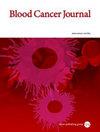细胞骨架动力学和线粒体重排驱动细胞命运在抗体诱导的补体激活DLBCL。
IF 11.6
1区 医学
Q1 HEMATOLOGY
引用次数: 0
摘要
补体依赖性细胞毒性(CDC)是多种治疗性抗体的重要效应功能。癌症对CDC的耐药性主要归因于细胞外因素。利用弥漫性大b细胞淋巴瘤(DLBCL)模型,我们阐明了细胞内逃避机制。通过CRISPR-Cas9文库筛选,我们发现线粒体损伤和活性氧是CDC的关键细胞内驱动因素。CDC抗性与线粒体质量增加、线粒体延长、线粒体自噬减少以及肌动蛋白相关基因表达减少有关。在cdc耐药细胞中,肌动蛋白下调特别发生在线粒体内,将线粒体重排和细胞骨架动力学与耐药联系起来。刺激肌动蛋白聚合可部分克服CDC抗性。具有临床意义的是,我们观察到DLBCL患者样本中细胞骨架和抗体反应之间存在正相关。总之,我们的研究揭示了抗体诱导的CDC的新的细胞内耐药机制,强调了线粒体重排和细胞骨架动力学在CDC中的关键作用。我们认为,线粒体肌动蛋白的减少可以防止线粒体自噬途径过载,从而减少CDC。本文章由计算机程序翻译,如有差异,请以英文原文为准。
Cytoskeletal dynamics and mitochondrial rearrangements drive cell fate upon antibody-induced complement activation in DLBCL.
Complement-dependent cytotoxicity (CDC) is an important effector function of various therapeutic antibodies. Cancer resistance to CDC is primarily attributed to extracellular factors. Using diffuse large B-cell lymphoma (DLBCL) models, we elucidated intracellular evasion mechanisms. By CRISPR-Cas9 library screening, we identified mitochondrial damage and reactive oxygen species as the key intracellular drivers of CDC. CDC resistance was linked to augmented mitochondrial mass, elongated mitochondria and reduced mitophagy, and decreased expression of actin-related genes. Actin downregulation in CDC-resistant cells occurred specifically within the mitochondria, connecting mitochondrial rearrangements and cytoskeletal dynamics with resistance. Stimulating actin polymerization could partially overcome CDC resistance. Of clinical significance, we observed a positive association between the cytoskeleton and antibody responses in DLBCL patient samples. In conclusion, our study unveils novel intracellular resistance mechanisms to antibody-induced CDC, highlighting the critical roles of mitochondrial rearrangements and cytoskeletal dynamics in CDC. We propose that decreased mitochondrial actin prevents overload of the mitophagy pathway, thereby reducing CDC.
求助全文
通过发布文献求助,成功后即可免费获取论文全文。
去求助
来源期刊

Blood Cancer Journal
ONCOLOGY-
CiteScore
16.70
自引率
2.30%
发文量
153
审稿时长
>12 weeks
期刊介绍:
Blood Cancer Journal is dedicated to publishing high-quality articles related to hematologic malignancies and related disorders. The journal welcomes submissions of original research, reviews, guidelines, and letters that are deemed to have a significant impact in the field. While the journal covers a wide range of topics, it particularly focuses on areas such as:
Preclinical studies of new compounds, especially those that provide mechanistic insights
Clinical trials and observations
Reviews related to new drugs and current management of hematologic malignancies
Novel observations related to new mutations, molecular pathways, and tumor genomics
Blood Cancer Journal offers a forum for expedited publication of novel observations regarding new mutations or altered pathways.
 求助内容:
求助内容: 应助结果提醒方式:
应助结果提醒方式:


